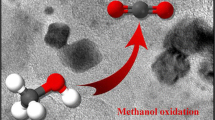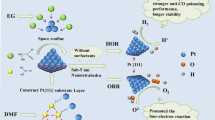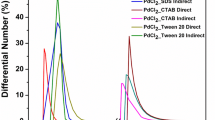Abstract
In this study, platinum nanoparticles have been prepared using PtCl4 as a starting material and 1-hexylamine, N-methylhexylamine, N,N-dimethylhexylamine, 1-heptylamine, N-methylheptylamine, and N,N-dimethylheptylamine as surfactants. All these surfactants were used in this synthesis, for the first time, to explore the effect of primary, secondary, and tertiary amine and chain length on the size and catalytic activity toward C1–C3 alcohol electro-oxidation. The electrochemical performance of all catalysts was determined using cyclic voltammetry and chronoamperometry. These techniques indicate that the highest electrocatalytic performance was generally observed when electrochemical surface area (ECSA), percent platinum utility, roughness factor, and the number of CH3 groups attached to the nitrogen atom is higher and the chain length shorter (C6H13). In addition, other important properties such as the crystal structure of platinum, size, and distribution of the platinum nanoparticles on the carbon support, and Pt(0) to Pt(IV) ratio, were determined using X-ray photoelectron spectroscopy, X-ray diffraction, atomic force microscopy, and transmission electron microscopy. It was found that increasing ECSA, Pt(0)/Pt(IV) ratio, % Pt utility, and roughness factor improves the C1–C3 alcohol oxidation catalytic performance.






Similar content being viewed by others
References
Deivaraj TC, Chen WX, Lee JY (2003) Preparation of PtNi nanoparticles for the electrocatalytic oxidation of methanol. J Mater Chem 13:2555–2560
Ertan S, Sen F, Sen S, Gokagac G (2012) Platinum nanocatalysts prepared with different surfactants for C1 to C3 alcohol oxidations and their surface morphologies by AFM. J Nanoparticle Res 14:922–926
Gökağaç G, Kennedy BJ, Cashion JD, Brown L (1993) Characterization of carbon-supported Pt–Sn Bimetallic catalysts for the electrochemical oxidation of methanol. Faraday Trans 89:151–157
Goodenough JB, Hamnett A, Kennedy BJ, Manoharan R, Weeks SA (1988) Electrocatalysis of direct methanol fuel cells. J Electroanal Chem 240:133–145
Gupta SS, Datta J (2005) An investigation into the electro-oxidation of ethanol and 2-propanol for application in direct alcohol fuel cells (DAFCs). J Chem Sci 117:337–344
Kadirgan F, Beyhan S, Atilan T (2009) Preparation of bimetallic Pd–Co nanoparticles on graphene support for use as methanol tolerant oxygen reduction electrocatalysts. Int J Hydrogen Energy 34(10):4312–4320
Kim YT, Mitani T (2006) Surface thiolation of carbon nanotubes as supports: a promising route for the high dispersion of Pt nanoparticles for electrocatalysts. J Catal 238:394–401
Klug H, Alexander L (1954) X-ray diffraction procedures, 1st edn. Wiley, New York
Lamy C, Belgsir EM, Leger JM (2001) Electrocatalytic oxidation of aliphatic alcohols: application to the direct alcohol fuel cell (DAFC). J Appl Electrochem 31:799–809
Lamy C, Lima A, LeRhun V, Delime F, Coutanceau C, Leger JM (2002) Recent advances in the development of direct alcohol fuel cells. J Power Sources 105:283–296
Lamy C, Rousseau S, Belgsir EM, Coutanceau C, Léger JM (2004) Recent progress in the direct ethanol fuel cell: development of new platinum–tin electrocatalysts. Electrochim Acta 49:3901–3908
Liang L, Sun G, Sun S, Liu J, Tang S, Li H, Zhou B, Xin Q (2005) Structure and chemical composition of supported Pt–Sn electrocatalysts for ethanol oxidation. Electrochim Acta 50:5384–5389
Liu ZL, Lee JY, Han M, Chen WX, Gan LM (2002) Radiation induced synthesis of Pt nanoparticles supported on carbon nanotubes. J Mater Chem 12:2453–2458
Liu Z, Ling XY, Su X, Lee JY (2004) One-pot protocol for bimetallic Pt/Cu hexapod concave nanocrystals with enhanced electrocatalytic activity. J Phys Chem B10:8234–8240
Liu Z, Yu C, Russakova IA, Huang D, Strasser P (2008) Synthesis of Pt3Co alloy nanocatalyst via reverse micelle for oxygen reduction reaction in PEMFCs. Top Catal 49:241–250
Otomo JL, Kobayashi X, Wen T, Nagamoto C-J, Takahashi H (2004) AC-impedance spectroscopy of anodic reactions with adsorbed intermediates: electro-oxidations of 2-propanol and methanol on carbon supported Pt catalyst. J Electroanal Chem 573:99–109
Ozturk Z, Sen F, Sen S, Gokagac G (2012) The preparation and characterization of nano-sized Pt–Pd alloy catalysts and comparison of their superior catalytic activities for methanol and ethanol oxidation. J Mater Sci 47:8134–8144
Peuckert M (1984) XPS investigation of surface oxidation layers on a platinum electrode in alkaline solution. Electrochim Acta 29(10):1315–1320
Qi Z, Kaufman A (2003) Liquid-feed direct oxidation fuel cells using neat 2-propanol as fuel. J Power Sources 118:54–60
Radmiloviæ V, Gasteiger HA et al (1995) Structure and chemical composition of a supported Pt–Ru electrocatalyst for methanol oxidation. J Catal 154:98–104
Sen F, Gokagac G (2007a) Activity of carbon-supported platinum nanoparticles toward methanol oxidation reaction: role of metal precursor and a new surfactant, tert-octanethiol. J Phys Chem C 111:1467–1473
Sen F, Gokagac G (2007b) Different sized platinum nanoparticles supported on carbon: an XPS study on these methanol oxidation catalysts. J Phys Chem C 111(15):5715–5720
Sen F, Sen S, Gokagac G (2011a) Preparation and characterization of nano-sized Pt–Ru/C catalysts and their superior catalytic activities for methanol and ethanol oxidation. Phys Chem Chem Phys 13(4):6784–6792
Sen F, Sen S, Gokagac G (2011b) Efficiency enhancement of methanol/ethanol oxidation reactions on Pt nanoparticles prepared using a new surfactant, 1,1-dimethyl heptanethiol. Phys Chem Chem Phys 13(4):1676–1684
Vigier F, Rousseau S, Coutanceau C, Leger J-M, Lamy C (2006) Electrocatalysis for the direct alcohol fuel cell. Top Catal 40:1–4
Wang ZB, Yin GP, Shi PF (2005) Stable Pt–Ru/C catalysts prepared from new precursors by thermal reduction for direct methanol fuel cell. J Electrochem Soc 152:A2406–A2412
Watanabe M, Uchida M, Motoo S (1987) Preparation of highly dispersed Pt + Ru alloy clusters and the activity for the electrooxidation of methanol. J Electroanal Chem 229:395–406
Yonezawa T, Toshima N, Wakai C, Nakahara M, Nishinaka M, Tominaga T, Nomura H (2000) Carbon supported platinum–palladium catalysts for methanol and ethanol oxidation reactions. Colloids Surf A 169:35–45
Zhou W, Zhou Z, Song S, Li W, Sun G, Tsiakaras P, Xin Q (2003) Development of PtNi/C and PtSnNi/C nanocatalysts for energy conversion from ethanol electrooxidation. Appl Catal B 46:273–285
Zhou WJ, Zhou B, Li WZ, Zhou ZH, Song SQ, Sun GQ, Xin Q, Douvartzides S, Goula M, Tsiakaras P (2004) Performance comparison of low-temperature direct alcohol fuel cells with different anode catalysts. J Power Sources 126:16–22
Acknowledgments
The authors gratefully acknowledge TÜBİTAK (Türkiye Bilimsel ve Teknik Araştırma Kurumu, Grant 111T162) for financial support and the Central Laboratory of the Middle East Technical University for acquiring XPS, TEM, and elemental analyses. The authors also thank Dr. Michael W. Pitcher for editing and proofreading of this manuscript. F. Ş. and S. Ş thank the Middle East Technical University for Grant BAP-08-11-DPT2002K120510 and TÜBİTAK for 2211 scholarships.
Author information
Authors and Affiliations
Corresponding authors
Electronic supplementary material
Below is the link to the electronic supplementary material.
Rights and permissions
About this article
Cite this article
Şen, F., Gökağaç, G. & Şen, S. High performance Pt nanoparticles prepared by new surfactants for C1 to C3 alcohol oxidation reactions. J Nanopart Res 15, 1979 (2013). https://doi.org/10.1007/s11051-013-1979-5
Received:
Accepted:
Published:
DOI: https://doi.org/10.1007/s11051-013-1979-5




